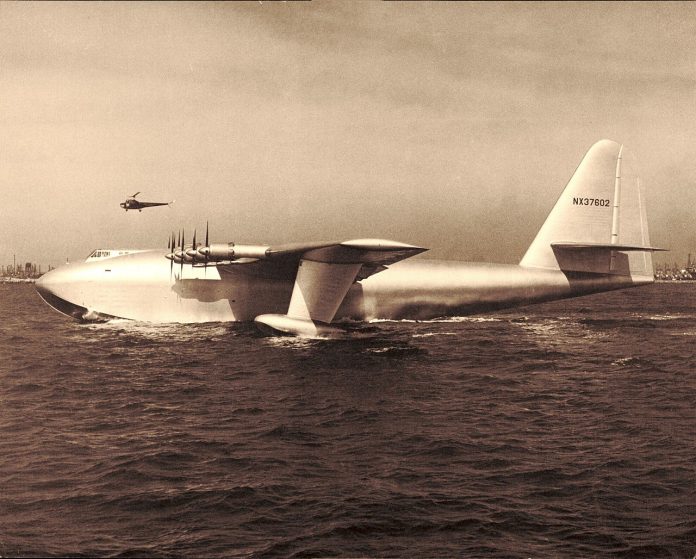Yesterday was a minor but fascinating aviation anniversary—70 years since the first, and only, flight of the Hughes H-4 Hercules, the largest aircraft by wingspan ever to have flown.
The aircraft was commissioned during World War II to transport either 750 soldiers or two tanks across the Atlantic Ocean, safe from the threat of German U-boats. It was a joint project between the millionaire aviation enthusiast and industrialist Howard Hughes, and shipbuilding magnate Henry J. Kaiser. Kaiser withdrew from the project in 1944 and the war had been over for more than two years before the aircraft flew.
Wartime restrictions on use of metals meant the aircraft was made largely of wood. It was 94 per cent constructed of yellow birch, which combined with its long and controversial gestation, gave it the nickname Spruce Goose, a title Hughes detested. It was powered by eight 28-cylinder Pratt & Whitney Wasp Major engines. These 3000 hp four-row radials were the largest and most complex aircraft piston engines ever made. Not surprisingly, the flight crew included two flight engineers. On November 2 1947, Howard Hughes took the H-4 out near Long Beach California, ostensibly for a taxi test. It lifted off at about 115 kt and flew about 1500 m at an altitude of up to 70 ft, landed and taxied back to its dock. It never flew again.
The Spruce Goose was preserved in Long Beach for many years, initially by Hughes’s corporation, but is now kept at the Evergreen Aviation & Space Museum in Oregon, where a local TV channel filed an informative report on the anniversary. Its record as the largest aircraft by wingspan stands to be broken by the Stratolaunch, nicknamed the Roc. The Roc, a Frankenstein’s monster mashup of two Boeing 747-400s, has been designed to launch satellites.
The Spruce Goose was in many respects a freak and dead-end, but some aspects of it prefigure modern aircraft design. Its Duramold construction of baked resin-impregnated plywood was similar in principle to modern carbon-fibre construction. Duramold was weight-for-weight stronger than aluminium alloy and made the aircraft light enough to fly with its (by jet engine standards) limited thrust. Carbon fibre construction is now a mainstream aviation technology, used in the Boeing 787 and Airbus A350. So here’s to the Spruce Goose, a pioneer after all.



